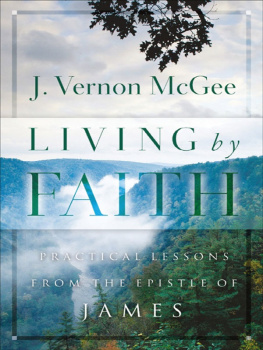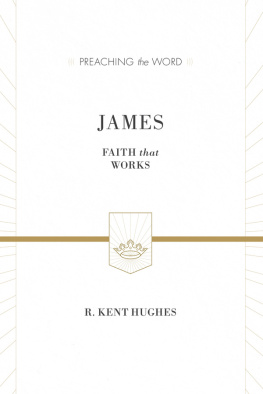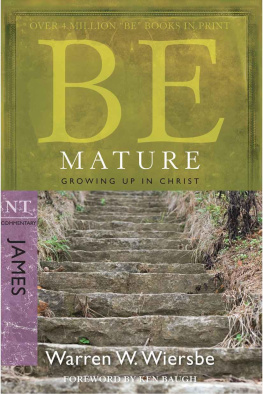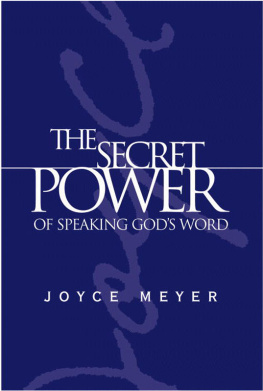Copyright 2019 by Joyce Meyer
Cover copyright 2019 by Hachette Book Group, Inc.
Hachette Book Group supports the right to free expression and the value of copyright. The purpose of copyright is to encourage writers and artists to produce the creative works that enrich our culture.
The scanning, uploading, and distribution of this book without permission is a theft of the authors intellectual property. If you would like permission to use material from the book (other than for review purposes), please contact permissions@hbgusa.com. Thank you for your support of the authors rights.
FaithWords
Hachette Book Group
1290 Avenue of the Americas, New York, NY 10104
faithwords.com
twitter.com/faithwords
First Edition: March 2019
FaithWords is a division of Hachette Book Group, Inc. The FaithWords name and logo are trademarks of Hachette Book Group, Inc.
The publisher is not responsible for websites (or their content) that are not owned by the publisher.
The Hachette Speakers Bureau provides a wide range of authors for speaking events. To find out more, go to www.hachettespeakersbureau.com or call (866) 376-6591.
Scripture taken from the Amplified Bible, Copyright 1954, 1958, 1962, 1964, 1965, 1987 by The Lockman Foundation. Used by permission of Zondervan.
Book of James from the Amplified Bible (AMP), Copyright 2015 by The Lockman Foundation. Used by permission. www.Lockman.org.
The Amplified trademark is registered in the United States Patent and Trademark Office by The Lockman Foundation. Use of this trademark requires the permission of The Lockman Foundation.
Scripture quotations marked NIV are taken from the Holy Bible, New International Version, NIV Copyright 1973, 1978, 1984, 2011 by Biblica, Inc. Used by permission. All rights reserved worldwide.
Scripture quotations marked NLT are taken from the Holy Bible, New Living Translation, copyright 1996, 2004, 2015 by Tyndale House Foundation. Used by permission of Tyndale House Publishers, Inc., Carol Stream, Illinois 60188. All rights reserved.
Scripture quotations marked NKJV are taken from the New King James Version. Copyright 1982 by Thomas Nelson. Used by permission. All rights reserved.
Library of Congress Cataloging-in-Publication Data has been applied for.
ISBNs: 978-1-5460-2606-8 (hardcover), 978-1-5460-3532-9 (large print), 978-1-5460-2603-7 (ebook)
E3-20190105-JV-NF-ORI
Author:James
Date:Approximately AD 48
Audience:Jewish Christians in the early church
James was a common name in New Testament times, as it is today. Two of Jesus twelve disciples were named James, but neither of them is the author of this letter. The author of this epistle is believed to be the James who is called the brother of Jesus, though he was technically his half-brother. Jesus and James both had Mary as their mother; Jamess father was Joseph, while Jesus Father was God Himself. Sometimes people do not see the greatness in their own family members because they are with those people all the time and they can see their flaws. Although James was the brother of Jesus, he recognized Him as the resurrected Lord, for he refers to himself as a servant of God and of the Lord Jesus Christ, which is very interesting and demonstrates Jamess humility because he could have easily written that he was the brother or relative of Jesus, but instead positions himself as a servant.
We can tell from the New Testament that James occupied a prominent place in the church in Jerusalem, and he is mentioned several times in the Book of Acts. In Acts 1:1314, we see that James was one of the people praying in the Upper Room, along with Peter, John, Mary, and others. In Acts 12:17, after an angel released Peter from prison (Acts 12:610), Peter wanted to make sure James knew he was free, mentioning him by name. Along with Peter, James led what is known as the Jerusalem Council, which discussed the relationship between Gentile followers of Jesus and the law of Moses. James summarizes his judgment on the issues in Acts 15:1321. When Paul returned to Jerusalem after some of his travels, he made a specific point to visit James (Acts 21:1719), along with the elders of the church, to tell them what God was doing through his ministry. In Galatians, Paul mentions seeing James again, on a separate journey. Obviously, James had close relationships with Peter and Paul and was instrumental in the beginnings of the early church.
Jamess epistle has so much to say about living a successful Christian life and addresses a variety of topics important to growing Christians. This book teaches us not only that we need to read the Word of God and know what it says, but also that we need to act on it. According to H. A. Ironside, The theme of the epistle is A Living Faith, a faith that is evidenced by righteous living and godly behavior (H. A. Ironside, James and 1 and 2 Peter: An Ironside Expository Commentary [Grand Rapids, MI: Kregel Publications, 1947; repr. 2008], 12). I like to describe a living faith as a faith that works and produces good things in our lives and in the lives of others.
One of the primary messages of this book is that true faith in God leads to good works. We serve God and do good works because of our genuine love for Him. There are all kinds of practical ways we can demonstrate our faith as we love God by loving other peoplehelping them, supporting them, encouraging them, and saying positive things to them and about them. We should always remember that good works do not prove that a person believes in God or has a relationship with Him, but that when we have faith in God, good works follow. Faith has to come first, because when good works are done in faith, God gets the glory.
There are five chapters in the Book of James, and H. A. Ironside describes them this way:
James 1: A Victorious Faith
James 2: A Manifested Faith
James 3: A Controlling and Energizing Faith
James 4: A Submissive Faith
James 5: A Patient and Expectant Faith
In five chapters, James covers many topics we need to understand as Christians. They include why tests and trials are important to the development of our faith and how we are to view them and endure them, wisdom, the importance of not being double-minded, persevering through challenges, resisting the devil, growing in faith, and praying effectively. In addition, James writes at length about the tongue, explaining how powerful our words can be. They can become dangerous to ourselves and to others when we use them carelessly, angrily, or without thinking, but they can bless and do good when we use them well.
The Book of James does not teach us much about specific doctrines of the Christian faith, as some epistles do, but offers us valuable lessons in practical Christian behavior and putting our faith into practice in the situations we face every day. For this reason, it is very important for us to read, study, and apply to our lives the truths and principles James provides for us. As you learn more about the Book of James, I pray that it will not only stir your faith in God but also inspire you to live righteously in practical ways and to do good works because of your love for Him and desire to glorify Him in your life.
Key Truths in James:
Even in the face of trials, we can find joy because trials produce good fruit in our lives, the fruit of endurance leading to spiritual growth and maturity.
















